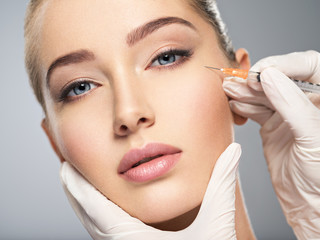Dermatologists are concerned with the health of our largest organ, the skin. They treat a wide range of conditions that show up on the skin, hair, and nails, and they diagnose broader medical conditions by observing symptoms.

If you have acne and over-the-counter treatments don’t work, Montgomery Dermatologists can help. They can also help minimize the effects of aging on your skin.
Dermatologists can diagnose skin problems just by looking at them, but they often perform additional tests to rule out other causes. These might include patch tests, where substances you may be allergic to are applied to your back, or a biopsy, in which a small sample of skin is removed and then studied under a microscope to check for cancerous cells or other abnormalities.
Dermatologist can also use a variety of surgical techniques to treat your condition. For instance, they can perform electrosurgery, which involves the surgical use of high-frequency electric currents to cut or destroy tissue; cryosurgery, in which extreme cold is used to freeze and destroy tissue; or excision surgery, in which a sharp knife (scalpel) is used to remove skin with appropriate closures. They can also perform mohs surgery, a procedure in which they remove a suspicious or dangerous-looking mole one layer at a time and then study it under a microscope to diagnose the cancerous cells.
In addition to examining and testing your condition, a dermatologist will offer you a number of treatments and medications. They can prescribe topical creams to treat acne, psoriasis and other diseases of the skin, including some autoimmune disorders. They can also perform peels, in which a chemical solution is applied to the skin and then peeled off to reveal regenerated, healthier-looking skin. A dermatologist can also give you injections to address fine lines, wrinkles and sagging skin, which can help with the aging process.
If your doctor believes your condition needs to be treated by another specialist, they will refer you to that person. They can also recommend or prescribe beauty products and services to treat your appearance concerns, such as cosmetic fillers.
Dermatologists work with patients of all ages, from newborns to people who are over 100 years old. They need to have extensive training to be able to care for people of all ages and a wide range of conditions and diseases of the skin, hair and nails. After graduating from medical school, which takes about four years at AUC, a dermatologist must spend three years in residency and complete 12,000 to 16,000 hours of treating patients.
They Help People Prevent Skin Issues
The skin is the largest organ in the body. It protects us from germs, repels water, and covers blood vessels, nerves, and organs. As the first line of defense, it takes a beating, which is why it’s important to perform regular self-checks of our skin and see a dermatologist for any unusual or suspicious lesions.
During an appointment, a dermatologist will ask about your medical history and symptoms. They will then conduct a physical exam, which might include the use of a dermatoscope and a full body examination from head to toe. They might also recommend a biopsy, which involves taking a small piece of tissue and examining it under a microscope to diagnose disease or rule out cancer. Depending on the results, a dermatologist may prescribe medication or recommend a surgical procedure. They may even refer you to a specialist, such as a dermatopathologist, who will examine the skin sample and make a diagnosis.
Dermatologists often work in private practice, either alone or as part of a group. They may be affiliated with a medical school and schedule teaching sessions alongside patient consults. Those without a fellowship can still stay up-to-date by attending conferences, workshops, and reading medical journals.
Aside from diagnosing and treating diseases and conditions, dermatologists can also help prevent them by providing preventive services. They can educate you about the importance of performing a monthly skin self-check and noting any changes in appearance or texture. They can also recommend sunscreens and suggest other lifestyle habits that can help lower your risk of developing a skin problem.
If you’re due for a check-up, choose a dermatologist who accepts your health insurance. You can find one on the American Academy of Dermatology’s website, which allows you to search by zip code or condition. It’s also a good idea to bring along a friend who can take notes, ask questions, and be an extra set of eyes and ears. This will keep you accountable to your appointment and help you remember what your doctor says. If you’re looking for a new dermatologist, it’s helpful to find one that you get along with and trust.
They Help People Deal With Age-Related Skin Issues
As the body’s largest organ, skin plays a critical role in protecting against heat, cold and germs; repelling water and covering vital blood vessels, nerves and organs. It’s also a great indicator of overall health. As a result, changes in the skin can often be signs of internal conditions, such as liver disease or kidney failure. Because of this, dermatologists are experts at recognizing these signals and determining whether they require specialized care.
Dermatologists are bona fide lifesavers. They treat a baby’s prominent birthmark that threatens her eyesight; remove a mother’s deadly melanoma at its earliest, most treatable stage; and offer relief for an elderly patient with a disfiguring rash that’s been plaguing him for years. They also perform a wide range of procedures, including electrosurgery (using high-frequency electric currents to cut or destroy tissue), cryosurgery (the surgical use of extreme cold to freeze and destroy tissue) and excision surgery (using a scalpel to remove an entire tissue with appropriate closures).
While many of the issues they treat are cosmetic, their work is incredibly important. As they swab and scrape the surface of their patients, they can detect bacterial infections and parasites; test for skin cancer; and determine if any moles are cancerous or precancerous. They can then use this information to help their patients take preventative measures and improve the health and appearance of their skin.
As people get older, their hormone levels fall and their skin takes longer to heal. This can lead to rashes, infections and other skin conditions. Regularly seeing a dermatologist can help prevent these problems. They can also help keep track of a patient’s health and alert them to potential internal issues, such as a slowing thyroid. In addition, because many dermatologists participate in research, they can often draw upon a wealth of literature on healthy aging to encourage their patients to eat well, exercise regularly and avoid smoking, which dramatically increases the risk of skin cancer.
They Help People Get the Best Anti-Aging Procedures
In addition to diagnosing and treating skin diseases, dermatologists often consult with other specialists—such as plastic surgeons, cosmetic or otolaryngologists (ear, nose and throat doctors), and endocrinologists—to provide comprehensive care. This is because the skin is the gateway to the rest of the body and it can reveal symptoms of internal problems like kidney or thyroid disease.
Dermatologists are in a position to educate patients about the differences between the clinical appearance of aging skin and the actual physiology of healthy aging. As such, they can help patients set realistic goals for their anti-aging treatment, including discussing the pros and cons of various procedures and cosmeceuticals.
Cosmetic procedures can be effective, affordable and safe for patients of all ages. Many non-invasive treatments, such as chemical peels, laser skin resurfacing, and injectables, can give patients more youthful looking skin. These anti-aging treatments can also be used to reduce the appearance of scars, blemishes and wrinkles.
Other cosmetic anti-aging treatments can include a variety of facial fillers, such as silicone and hyaluronic acid fillers, which are injected under the skin to reduce lines and wrinkles. These procedures are a lot less expensive and risky than surgical facelifts, and can produce results that last months.
Besides facial fillers, dermatologists can also perform injections of peptide creams to help lessen fine lines and wrinkles. These creams are made from amino acids and can stimulate the production of collagen in the skin, which helps slow down aging.
During an appointment, the dermatologist will examine the patient’s skin from head to toe and ask about any other issues they have, such as baldness or hair loss, that may be related to the skin issue. The dermatologist will then recommend a course of treatment, which may involve medications or surgical or non-surgical procedures. It’s helpful for patients to keep a symptom diary and bring it with them to the appointment, as this will help the doctor diagnose the issue. It’s also a good idea for patients to wear loose clothing and not apply any makeup or nail polish to their appointments, as this will make it easier for the dermatologist to conduct an accurate examination of the skin and nails.


